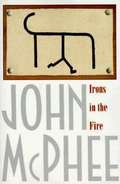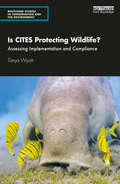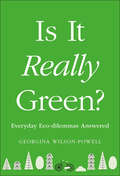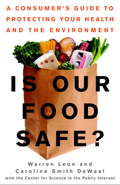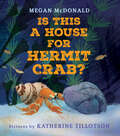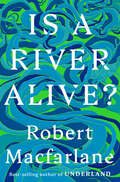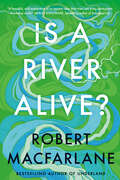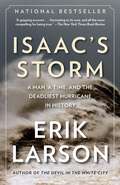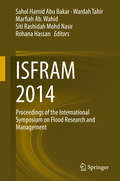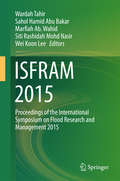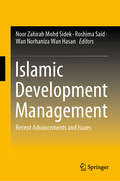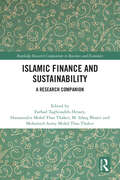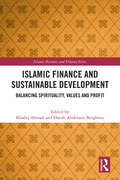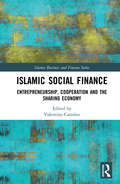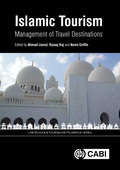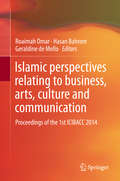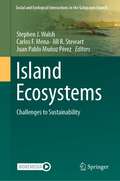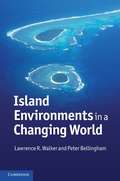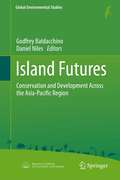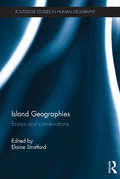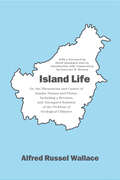- Table View
- List View
Irons in the Fire
by John McpheeAnother of McPhee's anthologies of well-written, highly informed, and very enjoyable essays that originally appeared in the New Yorker magazine. Joihn McPhee has a talent for making any subject interesting, and the diversity of the subjects he shares with his readers just in this book is astounding - from branding cattle to mountains made of tires to forensic geology to Plymouth Rock, and more.
Is CITES Protecting Wildlife?: Assessing Implementation and Compliance (Routledge Studies in Conservation and the Environment)
by Tanya WyattThis book assesses the Convention on International Trade in Endangered Species of Wild Fauna and Flora (CITES), examining both implementation and compliance. Humans are causing a biodiversity crisis, where 1 million species are facing extinction. Species are dying, in no small part, because they are overexploited, poached and trafficked and CITES is the main international instrument designed to protect traded wildlife. Does the state of the world’s species mean CITES is failing? This book explores the implementation of and compliance with CITES by all 183 member countries. It is imperative we know the nature and extent of the implementation of and compliance with CITES legislation in all parties to fully understand the impact of legal and illegal trade on species survival. Through extensive legislative content analysis, a Delphi iterative survey, and semi-structured interviews, this is the first book to share empirical research about CITES implementation and compliance. This book contains a comprehensive analysis of the state of CITES, what is done well, what could be done better, and what the future might bring to try to curtail the slide of the world’s wildlife into extinction. By identifying lessons learned in relation to CITES legislation, implementation and compliance this book provides hard evidence to member countries as to how their own practice can be improved. This timely book will be essential reading for students and academics interested in wildlife law, trade and trafficking, green criminology and biodiversity conservation more broadly. It will also be of interest to professionals working in wildlife law enforcement.
Is It Really Green?: Everyday Eco Dilemmas Answered
by Georgina Wilson-PowellFind clarity on everyday green-living dilemmas to maximize your sustainabilityAre paper bags always more environmentally friendly than plastic? How much better for the planet are electric cars? What saves more water - using the dishwasher or washing up by hand?We all want to do the right thing for the planet, but with so many factors at play, it can be difficult to work out which is the greenest way. With answers to more than 140 everyday green-living questions, Is It Really Green? cuts through the confusion and gives you the facts.Get to the heart of each eco-conundrum, interrogate your instincts, and make informed decisions to reduce your ecological footprint.
Is Our Food Safe? A Consumer's Guide to Protecting Your Health and the Environment
by Warren Leon Caroline Smith DewaalEvery day, new warnings emerge about the safety of the food in our markets, school cafeterias, and restaurants. As industry and government officials rush in with reassurances--and food alarmists call for drastic changes in the American diet--ordinary consumers are caught in the middle. Is Our Food Safe?separates the facts from the rumors and offers straightforward, reliable advice on how to protect your health and the environment without going to extremes. Is Our Food Safe?answers common questions about the safety of meat, dairy products, fish, fruits, and other foods that make up our daily diet. It assesses the positive and negative aspects of genetically engineered foods, compares organic and conventionally produced foods, and makes recommendations about when (and if) you should choose local suppliers over industry giants. It also explains which foods to eat and which to avoid if you are concerned about clean water and air and a safe environment. Finally, it provides valuable information on how you can improve the quality of the food available in your communities, including specific issues to raise with grocers and food service providers.
Is Science Enough?: Forty Critical Questions About Climate Justice (Myths Made in America)
by Aviva ChomskyWhy social, racial, and economic justice is just as crucial as science in determining how humans can reverse climate catastrophe.We are facing a climate catastrophe. A plethora of studies describe the damage we&’ve already done, the droughts, the wildfires, the super-storms, the melting glaciers, the heat waves, and the displaced people fleeing lands that are becoming uninhabitable. Many people understand that we are facing a climate emergency, but may be fuzzy on technical, policy, and social justice aspects. In Is Science Enough?, Aviva Chomsky breaks down the concepts, terminology, and debates for activists, students, and anyone concerned about climate change. She argues that science is not enough to change course: we need put social, racial, and economic justice front and center and overhaul the global growth economy.Chomsky&’s accessible primer focuses on 5 key issues:1) Technical questions: What exactly are &“clean,&” &“renewable,&” and &“zero-emission&” energy sources? How much do different sectors (power generation, transportation, agriculture, industry, etc.) contribute to climate change? Can forests serve as a carbon sink?2) Policy questions: What is the Green New Deal? How does a cap-and-trade system work? How does the United States subsidize the fossil fuel industry?3) What can I do as an individual?: Do we need to consume less? What kinds of individual actions can make the most difference? Should we all be vegetarians?4) Social, racial, and economic justice: What&’s the relationship of inequality to climate change? What do race and racism have to do with climate change? How are pandemics related to climate change?5) Broadening the lens: What is economic growth? How important is it, and how does it affect the environment? What is degrowth?
Is This a House for Hermit Crab?
by Megan McDonaldFollow a hermit crab on the perilous journey to replace his outgrown shell in this classic picture book by the author of the popular Judy Moody and Stink series.Hermit Crab has outgrown his shell, and it&’s time for a new home to keep him safe from predators. The beach is strewn with possible choices, but none are quite right. A rock is too heavy; a tin can is too noisy; a fishing net has too many holes. He stepped along the shore,by the sea, in the sand . . .scritch-scratch, scritch-scratchWhen a giant wave sends Hermit Crab careening toward a hungry porcupine fish, will he find a hiding place in time? Katherine Tillotson&’s immersive artwork breathes new life into this classic text by Megan McDonald, beloved author of the Judy Moody series. Brand-new backmatter provides further learning about all things hermit crab.A Junior Library Guild Gold Standard Selection
Is a River Alive?
by Robert MacfarlaneA #1 Sunday Times (UK) Bestseller • A New York Times "New Nonfiction to Read This Spring" Recommendation • A Guardian "Nonfiction to Look Forward To in 2025" Pick • A Washington Post "Book to Watch For" in 2025 • A Financial Times "What to Read in 2025" Selection • A Goodreads Most Anticipated Book of 2025 <P> From the best-selling author of Underland and "the great nature writer…of this generation" (Wall Street Journal), a revelatory book that transforms how we imagine rivers—and life itself. <P> Hailed in the New York Times as “a naturalist who can unfurl a sentence with the breathless ease of a master angler,” Robert Macfarlane brings his glittering style to a profound work of travel writing, reportage, and natural history. Is a River Alive? is a joyful, mind-expanding exploration of an ancient, urgent idea: that rivers are living beings who should be recognized as such in imagination and law. <P> Macfarlane takes readers on three unforgettable journeys teeming with extraordinary people, stories, and places: to the miraculous cloud-forests and mountain streams of Ecuador, to the wounded creeks and lagoons of India, and to the spectacular wild rivers of Canada—imperiled respectively by mining, pollution, and dams. Braiding these journeys is the life story of the fragile chalk stream a mile from Macfarlane’s house, a stream who flows through his own years and days. <P> Powered by dazzling prose and lit throughout by other minds and voices, Is a River Alive? will open hearts, challenge perspectives, and remind us that our fate flows with that of rivers—and always has. <b>New York Times Bestseller</b>
Is a River Alive?
by Robert MacfarlaneFrom the celebrated writer, observer and naturalist Robert Macfarlane comes a brilliant, perspective-shifting new book, which answers a resounding "yes" to the question of its title.At the heart of Is a River Alive? is a single, transformative idea: that rivers are not mere matter for human use, but living beings, who should be recognized as such in both imagination and law. Macfarlane takes the reader on a mind-expanding global journey into the history, futures, people and places of the ancient, urgent concept.Around the world, rivers are dying from pollution, drought and damming. But a powerful movement is also underway to recognize the lives and the rights of rivers, and to re-animate our relationships with these vast, mysterious presences whose landscapes we share. The young "rights of nature" movement has lit up activists, artists, law-makers and politicians across six continents—and become the focus for revolutionary thinking about rivers in particular.The book flows like water, from the mountains to the sea, over three major journeys. The first is to northern Ecuador, where a miraculous cloud-forest and its rivers are threatened with destruction by Canadian gold-mining. The second is to the wounded rivers, creeks and lagoons of southern India, where a desperate battle to save the lives of these waterbodies is underway. The third is to northeastern Quebec, where a spectacular wild river—the Mutehekau or Magpie—is being defended from death by damming in a river-rights campaign led by an extraordinary Innu poet and leader called Rita Mestokosho.Is A River Alive? is at once a literary work of art, a rallying cry and a catalyst for change. It is a book that will open hearts, spark debates and challenge perspectives. A clarion call to re-centre rivers in our stories, law and politics, it invites us to radically re-imagine not only rivers but life itself. At the heart of this vital, beautiful book is the recognition that our fate flows with that of rivers—and always has.
Is the Environment a Luxury?: An Inquiry into the relationship between environment and income (Routledge Explorations in Environmental Economics)
by Silvia Tiezzi Chiara MartiniThe purpose of this collection of essays is to shed some light on the complex relationship between environmental quality and the distribution of income. Are the preferences of the poor towards a cleaner environment really different from those of the rich? Environmental economists have traditionally focused on efficiency issues. In their analyses the quality of the environment is usually related to aggregate or average variables, like per capita income; policy recommendations are usually formulated considering efficiency with no regard for equity and also the predicted effects of policies are evaluated in aggregate terms. The essays collected in this volume go into the problem of the relationship between environmental quality and income distribution. The book’s opening essay shows how different theories of economic growth and environmental quality seem to suggest that the higher the level of income the higher is the value of environmental protection. The essays that follow, a mix of already published papers and of papers solicited for this book, analyse the relationship between environmental quality and income distribution from different perspectives (both micro and macro) and on the basis of more than one methodology. This book highlights that the preferences of the poor towards a cleaner environment may differ from those of the rich, but income is also very likely to represent only one factor affecting them. The essays consider other relevant factors affecting preferences for environmental quality. What clearly emerges is that the distribution of costs and benefits of environmental policies is the key for their successful implementation, and that further research is needed to both address the distributional effects themselves and the strategies to mitigate them.
Isaac's Storm: A Man, a Time, and the Deadliest Hurricane in History
by Erik LarsonAt the dawn of the twentieth century, a great confidence suffused America. Isaac Cline was one of the era's new men, a scientist who believed he knew all there was to know about the motion of clouds and the behavior of storms. The idea that a hurricane could damage the city of Galveston, Texas, where he was based, was to him preposterous, "an absurd delusion." It was 1900, a year when America felt bigger and stronger than ever before. Nothing in nature could hobble the gleaming city of Galveston, then a magical place that seemed destined to become the New York of the Gulf.That August, a strange, prolonged heat wave gripped the nation and killed scores of people in New York and Chicago. Odd things seemed to happen everywhere: A plague of crickets engulfed Waco. The Bering Glacier began to shrink. Rain fell on Galveston with greater intensity than anyone could remember. Far away, in Africa, immense thunderstorms blossomed over the city of Dakar, and great currents of wind converged. A wave of atmospheric turbulence slipped from the coast of western Africa. Most such waves faded quickly. This one did not.In Cuba, America's overconfidence was made all too obvious by the Weather Bureau's obsession with controlling hurricane forecasts, even though Cuba's indigenous weathermen had pioneered hurricane science. As the bureau's forecasters assured the nation that all was calm in the Caribbean, Cuba's own weathermen fretted about ominous signs in the sky. A curious stillness gripped Antigua. Only a few unlucky sea captains discovered that the storm had achieved an intensity no man alive had ever experienced.In Galveston, reassured by Cline's belief that no hurricane could seriously damage the city, there was celebration. Children played in the rising water. Hundreds of people gathered at the beach to marvel at the fantastically tall waves and gorgeous pink sky, until the surf began ripping the city's beloved beachfront apart. Within the next few hours Galveston would endure a hurricane that to this day remains the nation's deadliest natural disaster. In Galveston alone at least 6,000 people, possibly as many as 10,000, would lose their lives, a number far greater than the combined death toll of the Johnstown Flood and 1906 San Francisco Earthquake.And Isaac Cline would experience his own unbearable loss.Meticulously researched and vividly written, Isaac's Storm is based on Cline's own letters, telegrams, and reports, the testimony of scores of survivors, and our latest understanding of the hows and whys of great storms. Ultimately, however, it is the story of what can happen when human arrogance meets nature's last great uncontrollable force. As such, Isaac's Storm carries a warning for our time.
Isfram 2014
by Wardah Tahir Sahol Hamid Abu Bakar Marfiah Ab. Wahid Siti Rashidah Mohd Nasir Rohana HassanThis book highlights research in flood related areas and sustainable management conducted by researchers around the world, compiling their innovative work in order to share best practices for managing floods and recommended flood solutions. The individual papers cover the fundamentals and latest advances in the areas of flood research and management, providing in-depth coverage complemented by illustrations, diagrams and tables. The book offers a valuable source of information on methods and state-of-the art technology for effective flood management.
Isfram 2015
by Wardah Tahir Sahol Hamid Abu Bakar Marfiah Ab. Wahid Siti Rashidah Mohd Nasir Wei Koon LeeThis book focuses on international research in flood-related areas and sustainable management. It consists of a compilation of innovative works, demonstrating best practices in flood management and recommend flood solutions. The selected papers cover the fundamentals and latest advances in the area, complete with illustrations, diagrams and tables. These proceedings serve as a source of information and state-of-the-art technology in managing floods to improve quality of life.
Islamic Development Management: Recent Advancements and Issues
by Noor Zahirah Mohd Sidek Roshima Said Wan Norhaniza Wan HasanThis book examines a range of current issues in Islamic development management. The first part of the book explores practical issues in governance and the application of Islamic governance in new areas such as quality management systems and the tourism industry, while the second delves into questions of sustainability. The book proposes a new Islamic sustainability and offers new perspectives on CSR in connection with waqf (Islamic endowments) and microfinance. The third part of the book addresses Islamic values and how they are applied in entrepreneurship, inheritance, consumer behavior and marketing. The fourth part examines the issues of waqf and takaful (a form of insurance in line with the Islamic laws), while the fifth discusses the fiqh (the study of Islamic legal codes) and legal framework from the perspectives of entrepreneurship, higher education, reporting and inheritance (wills). The final chapter is dedicated to the application of Islamic principles in various other issues.Written in an accessible style, the book will appeal to newcomers to the field, as well as researchers and academics with an interest in Islamic development management.
Islamic Finance and Sustainability: A Research Companion (Routledge Research Companions in Business and Economics)
by Taghizadeh-Hesary, Edited by FarhadThis book offers a comprehensive overview of Islamic finance and sustainability, showcasing how Islamic financial instruments can support environmentally sustainable initiatives.It delves into recent efforts to develop a Shariah-compliant financial and banking system that is sustainable, efficient, and stable. Contributors focus on Islamic financial products and tools, highlighting their potential to advance environmental sustainability. The discussions are organized around key themes, including the principles of sustainability in Islamic finance, risk assessment and mitigation, the Islamic stock market and sustainability, Green Fintech in Islamic banking and finance, and Green Sukuk in developing and emerging markets. The book addresses how Islamic finance can bridge the gap in green financing globally. Particular emphasis is placed on Green Sukuk, a Shariah-compliant bond created to fund environmentally sustainable projects, including those aimed at combating climate change and promoting ecological conservation.This comprehensive volume on Islamic finance and sustainability will be invaluable for policymakers, researchers, and academics interested in Islamic economics and finance, sustainable finance, and the green economy.
Islamic Finance and Sustainable Development: Balancing Spirituality, Values and Profit (Islamic Business and Finance Series)
by Khaliq Ahmad Datuk Abdelaziz BerghoutThis book uncovers a new dimension in the study of sustainability, offering balanced development from a spiritual and cultural values perspective. The authors of this edited volume investigate the role of religion in the debate concerning the Sustainable Development Goals (SDGs) and offer an Islamic perspective to environment, social and governance (ESG) issues.Applying a multidimensional approach to socio-economic development, this book contends that Islam offers a unique perspective and framework for sustainable development that is holistic and rooted in spirituality, morality and ethics. For example, the book explains how Islam lays emphasis on human talents development (SDGs 3 and 4), which is a key element in accelerating socio-economic growth (SDG-8). It also offers a wide range of social financial tools such as Zakat and Waqf that can be used to address SDGs 1 (poverty), 2 (hunger), 5 (gender equality) and 10 (reducing inequality). Islamic finance offers a number of tools for long-term financing such as sukuk that can masterfully be used for building sustainable infrastructure (SDG-9). The study also reviews some Islamic principles from the Holy Qur'an that can positively SDGs.Students, scholars and researchers in the fields of Islamic economics and finance, sustainable development and socio-economic and environmental issues will find the book a valuable resource.
Islamic Finance and Sustainable Development: The Water, Food, Energy, and Climate Nexus (Islamic Business and Finance Series)
by Abdulkader ThomasThe proliferation of energy, agricultural, water and food insecurity can be attributed to a multitude of factors, including advancements in technology that have facilitated the technical and economic utilization of energy and water resources, environmental degradation, climate anomalies, mounting pressure on water resources due to escalating demand, and surging energy requirements. These challenges have been addressed from multiple perspectives, ranging from Islamic social finance to large scale project finance. Large corporations are also involved in tackling the environmental impact of climate change or operating in water stressed regions. This book argues, however, that there is little value to be gained from this activity when sustainability initiatives and frameworks are not being measured.The book surveys Islamic finance and sustainability theories, setting the stage to detail the actual work of businesses, banks, non-governmental organizations (NGOs), and multilateral agencies addressing water, food and energy insecurity. It examines case studies, which cover diverse aspects of sustainability, mostly, in the context of fragile economic and ecological situations, and discusses practical cases from an Islamic perspective, in which local and regional problems are addressed. An important feature of the book is the description of how Islamic social finance builds pathways to scale for the mobilization of funds as well as the expansion of sustainable ventures. Further, the unique issues of carbon markets are explored from the perspective of Shariah compliance as well as managing adverse events. The cases present replicable, scalable solutions. These unique stories align theory to reality and sometimes, they highlight the shortfalls in the theory.The cases allow researchers, academics and policy makers an opportunity to examine the effectiveness of theories and policies opposite real-life experiences and also give business and NGO leaders clear examples to follow.
Islamic Social Finance: Entrepreneurship, Cooperation and the Sharing Economy (Islamic Business and Finance Series)
by Valentino CattelanThe current dynamics of world economy show remarkable changes in the socio-economics of credit provision and entrepreneurship. If the emergence of the sharing economy is fostering innovative models of collaborative agency, networking and venture business, economic actors are also looking for a more sustainable development, able to foster profitability as well as community welfare. This book investigates Islamic social finance as a paramount example of this economy under change, where the balance between economic efficiency and social impact is contributing to the transformation of the market from an exchange- to a community-oriented institution. The collected essays analyse the social dimension of entrepreneurship from an Islamic perspective, highlighting the extent to which the rationales of "sharing," distribution and cooperation, affect the conceptualization of the market in Islam as a place of "shared prosperity." Moving from the conceptual "roots" of this paradigm to its operative "branches," the contributing authors also connect the most recent trends in the financial market to Shari‘ah-based strategies for community welfare, hence exploring the applications of Islamic social finance from the sharing economy, FinTech and crowdfunding to microcredit, waqf, zakat, sukuk and green investments. An illuminating reference for researchers, practitioners and policy-makers dealing with the challenges of a global market where not only is diversity being perceived as a value to be fostered, but also as an important opportunity for a more inclusive economy for everybody.
Islamic Tourism: Management Of Travel Destinations (Cabi Religious Tourism And Pilgrimage Series)
by Razaq Raj Kevin Griffin Ahmad JamalIslamic tourism is tourism primarily undertaken by its followers within the Muslim world. It is not just motivated by religious feeling―it also includes participants pursuing similar leisure experiences to non-Muslims but within the parameters set by Islam, and destinations are therefore not necessarily locations where Shari'a or full Islamic law is enacted. <P><P> Demand for Islamic tourism destinations is increasing as the Muslim population expands worldwide, with the market forecast to be worth US$238 billion by 2019. This book bridges the ever-widening gap between specialists within the religious, tourism, management and education sectors through a collection of contemporary perspectives. It provides practical applications, models and illustrations of religious tourism and pilgrimage management from a variety of international perspectives and introduces theories and models in an accessible structure.
Islamic perspectives relating to business, arts, culture and communication
by Roaimah Omar Hasan Bahrom Geraldine De MelloThis timely book explores how the Malays and Muslims in general are faced with challenges in the fields of business, economy and politics, in the modern era of globalisation. These research findings can help the Muslim community to enhance international integration, particularly in Malaysia and Southeast Asia. In this work, scholarly and expert authors explore Islamic perspectives on communication, art and culture, business, and law and policy. They respond to the need to uphold and strengthen the culture, arts and heritage of the Malays. Readers are invited to explore the challenges for the Malay and Muslim world and to evolve strategies to ensure competitiveness, dynamism and sustainability. Topics such as Islamophobia, drug trafficking, savings behaviours and the role of social media are addressed. These reviewed papers were presented at the International Conference on Islamic Business, Art, Culture & Communication 2014, held in Melaka, Malaysia. They have the potential to strengthen aspects of Islamic economy and leadership, if translated into action plans. This book represents essential reading for scholars of Islamic studies and will be of interest to those examining Southeast Asia and the Malay world.
Island Ecosystems: Challenges to Sustainability (Social and Ecological Interactions in the Galapagos Islands)
by Stephen J. Walsh Carlos F. Mena Jill R. Stewart Juan Pablo Muñoz PérezSustainable development is a process to improve the quality of life of people, while maintaining the ability of social–ecological systems to continue to provide valuable ecological services that social systems require. In the Galapagos Islands, the maintenance of amenity resources to support tourism and the quality of life of residents is explicitly linked to ecosystem goods and services, particularly, the accessibility to high-quality natural environments and the terrestrial and marine visitation sites that showcase iconic species.On June 26-30, 2022, the Galapagos Science Center celebrated its 10-Year Anniversary. As the crowning event of the anniversary celebration, the World Summit on Island Sustainability was held on San Cristobal Island, Galapagos Archipelago of Ecuador. The intent of the World Summit was to bring together leading experts on island ecosystems and, particularly, on island sustainability from across the globe to represent a diversity of perspectives, approaches, and stakeholder groups. The World Summit was an exclusive event that featured an “expert convening” of scholars and practitioners to address the social, terrestrial, and marine sub-systems of the Galapagos Islands and other similarly challenged island ecosystems from around the globe. The World Summit attracted 150 scientists to the Galapagos Islands to discuss projects conducted, for instance, in the Galapagos Islands, Hawaii, Guam, French Polynesia, Chile, Australia, and the Caribbean Islands. Island vulnerability, resilience, and sustainability were examined by scholars, for instance, from the University of North Carolina at Chapel Hill, Universidad San Francisco de Quito, Catholic University of Chile, University of Guam, James Cook University, University of the Sunshine Coast, North Carolina State University, North Carolina Museum of Natural Sciences, California Academy of Sciences, University of San Francisco, and the University of South Alabama as well as affiliated scientists from Exeter University, University of Edinburgh, University of Southampton, and the Galapagos National Park. The World Summit also included scholars from Re:wild, World Wildlife Fund, EarthEcho, and the East-West Center, Hawaii.
Island Environments in a Changing World
by Lawrence R. Walker Peter BellinghamIslands represent unique opportunities to examine human interaction with the natural environment. They capture the human imagination as remote, vulnerable and exotic, yet there is comparatively little understanding of their basic geology, geography, or the impact of island colonization by plants, animals and humans. This detailed study of island environments focuses on nine island groups, including Hawaii, New Zealand and the British Isles, exploring their differing geology, geography, climate and soils, as well as the varying effects of human actions. It illustrates the natural and anthropogenic disturbances common to island groups, all of which face an uncertain future clouded by extinctions of endemic flora and fauna, growing populations of invasive species, and burgeoning resident and tourist populations. Examining the natural and human history of each island group from early settlement onwards, the book provides a critique of the concept of sustainable growth and offers realistic guidelines for future island management.
Island Futures
by Daniel Niles Godfrey BaldacchinoIslands face one of the most pressing issues of our time: how to balance ecological integrity with economic development and collective quality of life, including the need for social and conservation space. Islands are sites of rich and varied human and ecological diversity, but they are also often characterized by narrow resource bases and dependency on links to the outside world, and by their limited ability to determine the actual character of those links. This volume reviews the challenges of island development and conservation in the Asia-Pacific region. With emphasis on nature reserves and UNESCO World Heritage sites, chapters describe the benefits, barriers, and potential pitfalls in preserving such sites, managing biota, and attracting and controlling tourism. The book also provides a provocative challenge to move beyond the typical concerns of "sustainability" to the more holistic concept of "futurability", or "future potential" for convivial human-environmental interactions.
Island Geographies: Essays and conversations (Routledge Studies in Human Geography)
by Elaine StratfordIslands and their environs – aerial, terrestrial, aquatic – may be understood as intensifiers, their particular and distinctive geographies enabling concentrated study of many kinds of challenges and opportunities. This edited collection brings together several emerging and established academics with expertise in island studies, as well as interest in geopolitics, governance, adaptive capacity, justice, equity, self-determination, environmental care and protection, and land management. Individually and together, their perspectives provide theoretically useful, empirically grounded evidence of the contributions human geographers can make to knowledge and understanding of island places and the place of islands. Nine chapters engage with the themes, issues, and ideas that characterise the borderlands between island studies and human geography and allied fields, and are contributed by authors for whom matters of place, space, environment, and scale are key, and for whom islands hold an abiding fascination. The penultimate chapter is rather more experimental – a conversation among these authors and the editor – while the last chapter offers timely reflections upon island geographies’ past and future, penned by the first named professor of island geography, Stephen Royle.
Island Life: Or, the Phenomena and Causes of Insular Faunas and Floras, Including a Revision and Attempted Solution of the Problem of Geological Climates
by Alfred Russel WallaceAlfred Russel Wallace is best known as the codiscoverer, with Charles Darwin, of natural selection, but he was also historyOCOs foremost tropical naturalist and the father of biogeography, the modern study of the geographical basis of biological diversity. "Island Life" has long been considered one of his most important works. In it he extends studies on the influence of the glacial epochs on organismal distribution patterns and the characteristics of island biogeography, a topic as vibrant and actively studied today as it was in 1880. The book includes historyOCOs first theory of continental glaciation based on a combination of geographical and astronomical causes, a discussion of island classification, and a survey of worldwide island faunas and floras. aaaaaaaaaaaThe year 2013 will mark the centennial of WallaceOCOs death and will see a host of symposia and reflections on WallaceOCOs contributions to evolution and natural history. This reissue of the first edition of "Island Life," with a foreword by David Quammen and an extensive commentary by Lawrence R. Heaney, who has spent over three decades studying island biogeography in Southeast Asia, makes this essential and foundational reference available and accessible once again. "
Island in a Storm: A Rising Sea, a Vanishing Coast, and a Nineteenth-Century Disaster that Warns of a Warmer World
by Abby SallengerIn the mid-nineteenth century, the Isle Derniere was emerging as an exclusive summer resort on the coast of the Gulf of Mexico. About one hundred miles from New Orleans, it attracted the most prominent members of antebellum Louisiana society. Hundreds of affluent planters and merchants retreated to the island, not just for its pleasures, but also to escape the scourge of yellow fever epidemics that ravaged cities like New Orleans each summer. Then, without warning, on August 10, 1856, a ferocious hurricane swept across the island, killing half of its four hundred inhabitants. The Isle Derniere was left barren, except for a strange forest standing in the surf. Drawing from a rich trove of newspaper articles, letters, diaries, and interviews, Abby Sallenger re-creates the chain of events that led a group of people to seek refuge on an exposed strip of land in the sea. He chronicles the dramatic course of the hurricane itself, as seen through the eyes of a diverse cast of real-life characters, including eighteen-year-old Emma Mille, her French father, a steamboat captain, a pastor, and a slave. Island in a Stormis the story of their bravery and cowardice, luck and misfortune, life and death. At the heart of this narrative lies another, equally compelling, story. Sallenger, an oceanographer, traces the insidious link between the environmental deaths across the Mississippi delta and the human deaths that occurred when the storm swept ashore. The result is a fascinating portrait of a coast in perpetual motion and a rising sea that made the Isle Derniere particularly vulnerable to a great hurricane. Ultimately,Island in a Stormis a cautionary environmental tale. Global warming is spreading the unique hazards of river deltas to coasts around the world, and the signs of what happened to Isle Derniere may soon be appearing on other islands. The account of this nineteenth-century disaster and its aftermath offers a vital historical lesson as we continue to develop precarious coastal locations whose vulnerability will only grow as sea levels rise across the globe.
